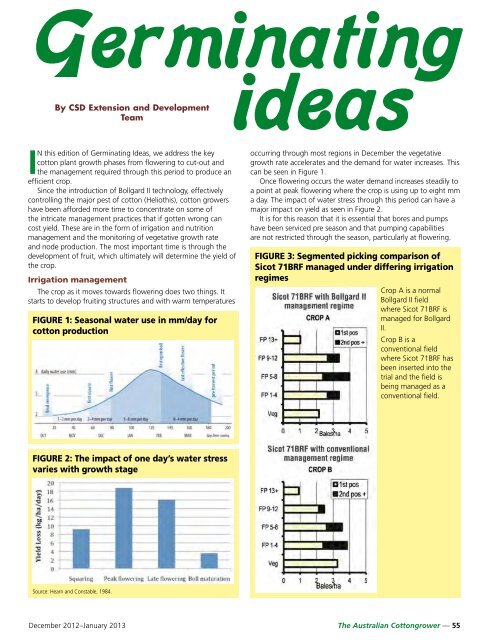cotton - Greenmount Press
cotton - Greenmount Press
cotton - Greenmount Press
You also want an ePaper? Increase the reach of your titles
YUMPU automatically turns print PDFs into web optimized ePapers that Google loves.
Germinating<br />
ideas<br />
By CSD Extension and Development<br />
Team<br />
IN this edition of Germinating Ideas, we address the key<br />
<strong>cotton</strong> plant growth phases from flowering to cut-out and<br />
the management required through this period to produce an<br />
efficient crop.<br />
Since the introduction of Bollgard II technology, effectively<br />
controlling the major pest of <strong>cotton</strong> (Heliothis), <strong>cotton</strong> growers<br />
have been afforded more time to concentrate on some of<br />
the intricate management practices that if gotten wrong can<br />
cost yield. These are in the form of irrigation and nutrition<br />
management and the monitoring of vegetative growth rate<br />
and node production. The most important time is through the<br />
development of fruit, which ultimately will determine the yield of<br />
the crop.<br />
Irrigation management<br />
The crop as it moves towards flowering does two things. It<br />
starts to develop fruiting structures and with warm temperatures<br />
FIGuRE 1: Seasonal water use in mm/day for <br />
<strong>cotton</strong> production<br />
occurring through most regions in December the vegetative<br />
growth rate accelerates and the demand for water increases. This<br />
can be seen in Figure 1.<br />
Once flowering occurs the water demand increases steadily to<br />
a point at peak flowering where the crop is using up to eight mm<br />
a day. The impact of water stress through this period can have a<br />
major impact on yield as seen in Figure 2.<br />
It is for this reason that it is essential that bores and pumps<br />
have been serviced pre season and that pumping capabilities<br />
are not restricted through the season, particularly at flowering.<br />
FIGuRE 3: Segmented picking comparison of<br />
Sicot 71BRF managed under differing irrigation<br />
regimes<br />
Crop A is a normal<br />
Bollgard II field<br />
where Sicot 71BRF is<br />
managed for Bollgard<br />
II.<br />
Crop B is a<br />
conventional field<br />
where Sicot 71BRF has<br />
been inserted into the<br />
trial and the field is<br />
being managed as a<br />
conventional field.<br />
FIGuRE 2: The impact of one day’s water stress<br />
varies with growth stage<br />
Source: Hearn and Constable, 1984.<br />
December 2012–January 2013 The Australian Cottongrower — 55

















